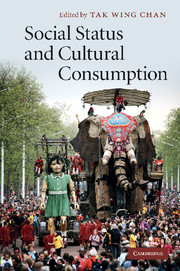Book contents
- Frontmatter
- Contents
- List of figures
- List of tables
- List of contributors
- Acknowledgments
- 1 Social status and cultural consumption
- 2 The social status scale: its construction and properties
- 3 Social stratification and musical consumption: highbrow–middlebrow in the United States
- 4 Bourdieu's legacy and the class–status debate on cultural consumption: musical consumption in contemporary France
- 5 Social status and public cultural consumption: Chile in comparative perspective
- 6 Social stratification and cultural participation in Hungary: a post-communist pattern of consumption?
- 7 Status, class and culture in the Netherlands
- 8 Social stratification of cultural consumption across three domains: music; theatre, dance and cinema; and the visual arts
- 9 Conclusion
- References
- Index
6 - Social stratification and cultural participation in Hungary: a post-communist pattern of consumption?
Published online by Cambridge University Press: 07 May 2010
- Frontmatter
- Contents
- List of figures
- List of tables
- List of contributors
- Acknowledgments
- 1 Social status and cultural consumption
- 2 The social status scale: its construction and properties
- 3 Social stratification and musical consumption: highbrow–middlebrow in the United States
- 4 Bourdieu's legacy and the class–status debate on cultural consumption: musical consumption in contemporary France
- 5 Social status and public cultural consumption: Chile in comparative perspective
- 6 Social stratification and cultural participation in Hungary: a post-communist pattern of consumption?
- 7 Status, class and culture in the Netherlands
- 8 Social stratification of cultural consumption across three domains: music; theatre, dance and cinema; and the visual arts
- 9 Conclusion
- References
- Index
Summary
Introduction
Since the collapse of communism in Hungary, major changes have occurred in the level and pattern of cultural consumption. Although the overall amount of leisure time has increased, there has been a significant decline in the amount of time spent attending concerts, theatres and cinemas or visiting museums (Falussy, 2004). In national surveys, the percentage of people who said they have attended a theatre in the year preceding the interview was 36% in 1986, but this had dropped to 23% by 2000 (Bukodi, 2005). Likewise, in the mid 1980s, 42% of Hungarians claimed to have visited a museum at least once over a 12-month period, but in 2000 this figure was only 22%.
In the light of these developments, further enquiry needs to be made into the social bases of cultural participation. This is the main objective of this chapter. More specifically, I investigate the association between individuals' cultural consumption across several different public domains – i.e. attendance at musical events, at theatres and cinemas, and at museums and galleries – and a range of different indicators of social stratification; and, in conclusion, I consider the applicability in the Hungarian case of rival theoretical arguments on the relationship between cultural and social stratification as outlined in Chapter 1.
In search of the social bases of cultural consumption in Hungary
The role of cultural and economic resources
Cultural participation is thought to be influenced by education in several different ways. Bourdieu (1984) argued that education increases individuals' ‘cultural capital’ and thus affects their ability to interpret and appropriate different expressions of culture.
- Type
- Chapter
- Information
- Social Status and Cultural Consumption , pp. 139 - 168Publisher: Cambridge University PressPrint publication year: 2010
- 5
- Cited by



